
 |
2001 Summer Tour to New York's Hudson ValleySponsored by Cornell Cooperative Extension's Northeastern New York Commercial Fruit Programarticle and pictures by Jon Clements, UMass Extension Tree Fruit Specialist |
On August 8, 2001, Cornell Cooperative Extension’s Northeastern NY Commercial Fruit Program sponsored a tour of the Cornell University (CU) Hudson Valley Lab (HVL) and commercial orchards in the New Paltz, NY area. CCE’s Kevin Iungerman led the tour, which was attended by growers and industry, research, and extension personnel from New York, Vermont, Massachusetts and Quebec. CU researchers Jim Schupp, Dick Straub, and Andrew Landers hosted us at the HVL, and visits to Dressel’s and Christ Brothers Orchards rounded out the tour. Here, briefly, are some highlights of the tour...
| Here, Jim Schupp shows excellent growth achieved from a modified grafting technique for apples. Commonly used in pecans, these 'pecan' grafts had a high success rate for ‘Liberty’ trees top-worked to ‘Honeycrisp’ this spring by Schupp at the HVL. Attendees were reminded that a royalty must be paid to the University of Minnesota (‘Honeycrisp’ breeder) for each tree grafted. |  |
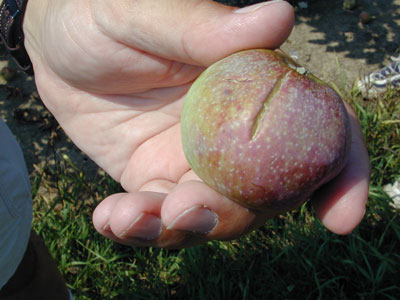 |
Although Apogee (BASF) shows promise as a growth and fireblight management tool, the PGR is not without issues -- including a ‘do not use’ on 'Empire' statement by Schupp because of fruit cracking problems, as evidenced by the photo at left. Schupp also said ‘absolutely do use’ a water conditioner (regardless of water hardness) and spreader-sticker with Apogee for maximum efficacy, particularly at lower rates. (Schupp also noted Roundup is the other chemical that should always have a water conditioner added to the tank.) |
| The HVL is home to a new planting (2001) of 50 ‘Honeycrisp’ strains, planted on B.9 rootstock. Schupp says the selections came from David Bedford, U. of Minnesota plant breeder, and are a collaborative effort to find a Honeycrisp strain with superior color and uniformity that would be desirable for the warmer growing areas of the Northeast, including the lower Hudson Valley. Bedford collected Honeycrisp scions with outstanding quality from around the country to be used in the planting. | 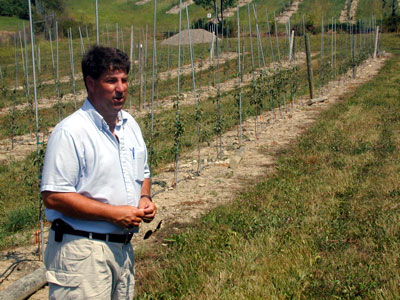 |
 |
Reducing drift and improving deposition was the subject of a couple of simple air-blast sprayer modifications being looked at by Geneva-based, NYSAES researcher Andrew Landers. First, he mentioned using ‘Surround’ crop protectant as a simple and inexpensive way to actually ‘see’ what your spray is hitting. Then he produced some simple metal deflectors to reduce ‘off-target’ drift when spraying border rows. Finally, here, he is looking at the promise of air-induction (AI) nozzles that operate at < 100 PSI (compared to 300 PSI for conventional nozzles) to reduce drift. |
| At Dressel’s Orchard -- a 300 acre diversified (apples, peaches, pears, cherries, cider, PYO strawberries and pumpkins), 100% fresh market (90% wholesale, 10% retail) operation -- the highlight was a block of vigorous Pioneer Mac/M.26 trees, including an experiment using Apogee with AI (air induction) nozzles. Growth control in these trees appears to be equally effective compared to those sprayed with Apogee using conventional air-blast sprayer nozzles according to Landers and Schupp. Final results of the study will be publicized this winter. | 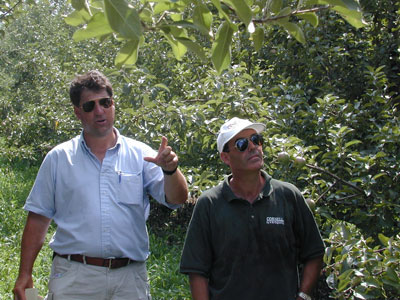 |
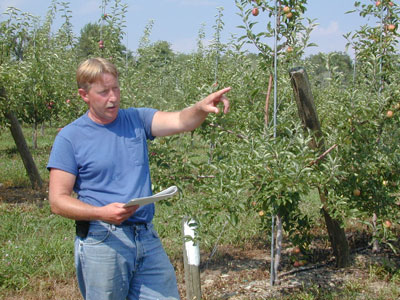 |
Hi-density, trickle irrigation, and ‘Honeycrisp’ experimentation were the focus of a visit to Crist Brothers Milton orchard. The Crist operation is large -- 600 acres of wholesale-only apples, with an average annual production of 250,000 boxes. Newer plantings are on M.26 rootstock, planted at 8 X 16, and trickle irrigated. (Good thing, as it has been a dry summer in the Hudson Valley.) At left, manager Rick Schoenmaker talks about the orchard history and challenges of running such a large commercial orchard. Below, although they have planted ten acres of the fruit, and prices remain high, Honeycrisp presents somewhat of a challenge, as evidenced by this sunburned fruit. (Would a little overhead sprinkler irrigation to prevent sunburn been a good investment?)
|
| Because Crist Brothers sports ten acres of Honeycrisp, Schupp has taken the opportunity to conduct several on-farm experiments aimed at solving production problems with this apple, including a high incidence of bitter-pit like fruit spotting, and how best to chemically thin Honeycrisp. This years harvest is not in yet, so the calcium spray experiment to alleviate the bitter-pit problem is in-progress, however, the thinning experiment results were clearly visible. As seen below, at least for this year, Accel (Valent) way over-thinned Honeycrisp (right photo), while on the left, a Sevin + NAA combination left a moderate crop of fruit on the tree. | |
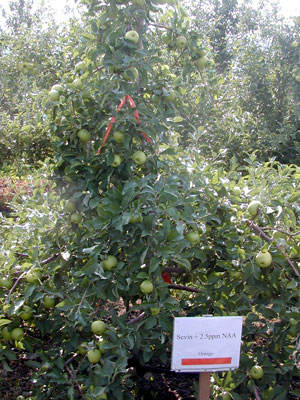 |
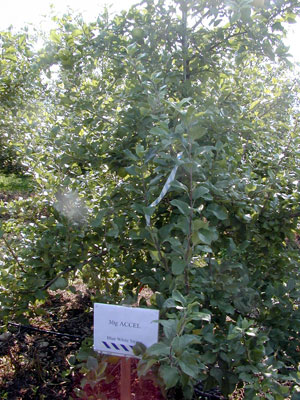 |
Thanks very much to Kevin, the Cornell researchers, and the growers we visited for hosting us and giving a truly informative tour!
What did you think of this article? Please let me know!
Copyright © 2001: Jon Clements, UMass Extension, and UMass Fruit Advisor